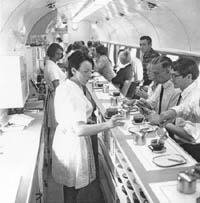NZHistory.net
![]() Gallery
Gallery
![]() Food and drink
Food and drink
|
|
|
NZHistory.net
|
Tea was a 'great mainstay'
of 'thirsty colonial New Zealand', the food historian Tony Simpson
claims. Nineteenth-century New Zealand imported considerable amounts of
tea, and legislation such Tea has continued to be the major hot beverage of choice throughout the twentieth century. It has formed an important part of picnics, as in this early twentieth-century image of a tea break during a tour of the West Coast. Tea has been a great
comforter after trauma and crises, such as during war, as this image of
New Zealand soldiers drinking tea in a recently captured German trench
suggests. Norman Gray fought on the Western Front during 1916/17, taking part in the actions around the Somme and Ypres, and his journal entries evoke the welcome relief that tea and the respite from activity gave to weary soldiers: It
had been raining for two and a half days and was still pouring. The walk
up the hill was just about the finish for most of us. We were drenched
to the bone,
utterly fagged after sixty hours of almost continuous work, and it required
a series of supreme efforts to keep from flopping into the mud�anywhere�and
letting things rip. Just on the ridge, before we reached our site, we
were greeted by the Y.M.C.A canteen, a cup of tea and two packets of biscuits
ready for every man. Tea has formed an
important part of 'smoko' for manual labourers; the tea break itself was
a hard-won right for workers. As the food historian David Burton notes,
substantial morning and afternoon teas were vital to sustain farm workers
and labouring people during their working day. These railway workers are
taking a break from laying tracks near Paremata in the 1950s to drink
their steaming tea from metal mugs, and eat their sandwiches from old
cake tins. 'Afternoon tea' suggests
a more genteel 'smoko': china cups and saucers rather than metal mugs,
tables and chairs instead of upturned bags or the bare ground. These teachers
taking tea in a classroom at Wellington's Te Aro School in the 1920s are
also enjoying cake and biscuits. Simpson suggests that New Zealand has a 'baking culture' with its roots in nineteenth-century Britain. That vital appliance for baking�the coal range or stove�was first manufactured locally in the 1870s. It was the major cooking appliance until after the Second World War when electric stoves, available from the 1920s, replaced it. The last coal ranges were made in New Zealand in 1965, but they remained in use after that, such as this one pictured here from the later 1960s. The consumption of coffee has grown over the last 50 years. The combined effects of the stationing of American servicemen in New Zealand, and the arrival of European refugees and settlers for whom coffee was the hot beverage of choice, boosted coffee consumption from the 1940s. The introduction of instant coffee in the 1960s  increased
it even further, and by the 1980s this was the most common way that coffee
was drunk. The latte scene is a recent urban phenomenon. Before the 1990s�and
still in cafeterias outside the heart of the main centres�instant coffee
was the most common way that coffee was served, as in this railways buffet
car in 1970. increased
it even further, and by the 1980s this was the most common way that coffee
was drunk. The latte scene is a recent urban phenomenon. Before the 1990s�and
still in cafeterias outside the heart of the main centres�instant coffee
was the most common way that coffee was served, as in this railways buffet
car in 1970. |
|
|
|